#shulmu
Explore tagged Tumblr posts
Text
Proclaiming the Year of ʾAlʾiyan-Baʿal
KTU 1.78 is quite a peculiar piece of ancient literature. It's an astrological report from Ugarit written in the City's own language and alphabet.¹ Despite being only six lines long, it has been the subject of extended discussion among scholars due to an ominous description of an astronomical event.² This event was identified early on by researchers with a solar eclipse dated to 1375 BCE, but a 1989 reexamination by astronomer Teije De Jong and Assyriologist W.H. van Soldt pointed to another solar eclipse, of 1223 BCE, as a more likely candidate.¹,³,⁴
This challenged the prevailing view of the timeframe of the Ugaritic texts.⁵ An even fuller picture thereof has emerged from research upon texts including those discovered in the house of a Diviner named Agaptharri.⁶ Three of these are particularly intriguing in relation to the Baʿal cycle, one of them even providing insight into the ritual aspect of the myth. It's classified as RS 24.293 and it involves 𒀭Mot, the God of Death who swallows up 𒀭Baʿal before being destroyed by 𒀭Maiden ʿAnat to restore Her Brother to life.⁷
The Fourth Tablet of Baʿal itself, written by the scribe Ilimilku of Shuban under 𒀭'King Niqmaddu IV of Ugarit (formerly reckoned Niqmaddu III) around the same time as the apparent eclipse, also contains a portion of broken text which bridges 𒀭Baʿal the Victorious' Great Theophany and His instructions to the Lads 𒀭Gapn and 𒀭ʾUgar to deliver His message to 𒀭Mot. Restoration of the text shows it appears to refer to the Sun, personified as 𒀭Shapash the Lamp of the Deities, being cloaked in gloom as a grim omen.⁸,⁹ I think it's easy to see the connection I'm making here; I believe these two eclipses can be taken together as a sort of symbolic epoch.
The date was recorded as the Month of Khiyyaru during the New Moon which was the first Day of the Month in the Ugaritic calendar.¹ This lunar calendar has twelve months beginning just before the Autumnal Equinox in September. There was a modern version on Tess Dawson's Natib Qadish website but it's no longer present and I'm interested in repurposing it if I can figure out the math involved (especially with intercalation).
In any case, under the De Jong and van Soldt dating we are now in Year 3248 of Baʿal the Victorious starting in late Summer of 2024 CE and ending in late Summer of 2025 CE. This is of course the first actual use of such a dating system, so it's only appropriate for it to take place on the civil New Year's Day. Shulmu 𒁲𒈬 and Happy New Year to all!
References
Wyatt, Nicolas. Religious Texts from Ugarit, 2nd ed, 366–67. The Biblical Seminar 53. London: Sheffield Academic Press, 2002.
Pardee, Dennis. Ritual and Cult at Ugarit, 131–32. Edited by Theodore J. Lewis. Writings from the Ancient World 10. Atlanta: Society of Biblical Literature, 2002.
De Jong, Teije, and Wilfred H. van Soldt. “Redating an Early Solar Eclipse Record (KTU 1.78): Implications for the Ugaritic Calendar and the Secular Accelerations of the Earth and Moon.” Jaarbericht Ex Oriente Lux 30 (January 1989): 65–77. https://www.researchgate.net/publication/274720180_Redating_an_Early_Solar_Eclipse_Record_KTU_178_Implications_for_the_Ugaritic_Calendar_and_the_Secular_Accelerations_of_the_Earth_and_Moon.
De Jong, Teije, and Wilfred H. van Soldt. “The Earliest Known Solar Eclipse Record Redated.” Nature 338 (March 16, 1989): 238–40. https://www.researchgate.net/publication/232779160_The_earliest_known_solar_eclipse_record_redated.
Pardee, 242.
Olmo Lete, Gregorio del, ed. “(Bn) Ảgpṯr / (Binu) Agapṯarri’s House: The Functional Analysis of an Ugaritian ‘Archive’ (PH Room 10).” In The Private Archives of Ugarit: A Functional Analysis, 27–54. Barcino Monographica Orientalia 11. Barcelona: Edicions de la Universitat de Barcelona, 2018. https://diposit.ub.edu/dspace/bitstream/2445/129766/1/9788491682394%20(Creative%20Commons).pdf.
Pardee, 211–14 (for the other two texts noted: Wyatt, 388–90 & 414–15).
Gibson, John C.L. Canaanite Myths and Legends, 66. Edited by G.R. Driver. London: T&T Clark International, 2004.
Wyatt, 111–12.
#pagan#semitic pagan#baal#anat#ugarit#canaan#paganism#semitic paganism#calendar#new year#astronomy#ancient near east#ancient history#shapash#history#shulmu#happy new year#ancient levant#bronze age#ugaritic#ugaritic mythology#canaanite#canaanite pagan#canaanite paganism#canaanite polytheism#polytheist#polytheism#phoenicia#phoenician#punic
12 notes
·
View notes
Text


Shulmu 𒁲𒈬, all. This is something I've been meaning to do for a while now, but I got to putting together this edition of the Shanatu Qadishti calendar, originally created by Tess Dawson based on the ancient Ugaritic ritual calendar, for this year and the next. As far as I can tell, this is the first time anything like this has been done in years, and it was rewarding if not somewhat frustrating.
Going by the ancient reckoning, a day of this calendar begins at Sunset on the Gregorian calendar day prior to the Shanatu Qadishti day's equivalent: So, for instance, Niqalu 0, 97 SQ, began at Sunset on September 1, 2024 CE, and ended at Sunset on Sep. 2, Niqalu 1 ran from the latter until Sunset on Sep. 3, Niqalu 2 from then until Sunset on Sep. 4, and so on. Chudthu and Mlatu days occur based on which sunset-to-sunset calendar day the corresponding lunar event falls in.
I've done my best to keep this faithful to Dawson's original scheme as to avoid confusion, but I actually did add one holiday of my own design: A Day of Lamentation for the Temple of 𒀭Baʿal-Shamin in ancient Tadmor/Palmyra, which was senselessly destroyed by ISIS terrorists on August 23, 2015 CE, followed shortly after by the Temple of 𒀭Bel at the same location. That day actually fell on the intercalary month of Shalamu per Dawson, and it wasn't possible to simply move it back a month as it would interrupt ʿAshuru Raʾshi Yeni, so I settled on Raʾshu Yeni 26 as a compromise. I'd hope such a day could be a valuable occasion for reflection and prayer, honoring victims of terrorism and intolerance.
Please note that this is a lunisolar calendar which operates based on lunation, and it's displayed here in accordance with the moon phases in my own locale. I've put the .XLSX files up in this Google Drive folder, so anyone can customize them to their utility with Google Sheets or Microsoft Excel. I used this website to figure the lunation out for myself, and it can be set to most any location (for instance, here it is set to the area of ancient Ugarit) with another tab for sunset times. Thanks for reading, I hope some of y'all find this useful!
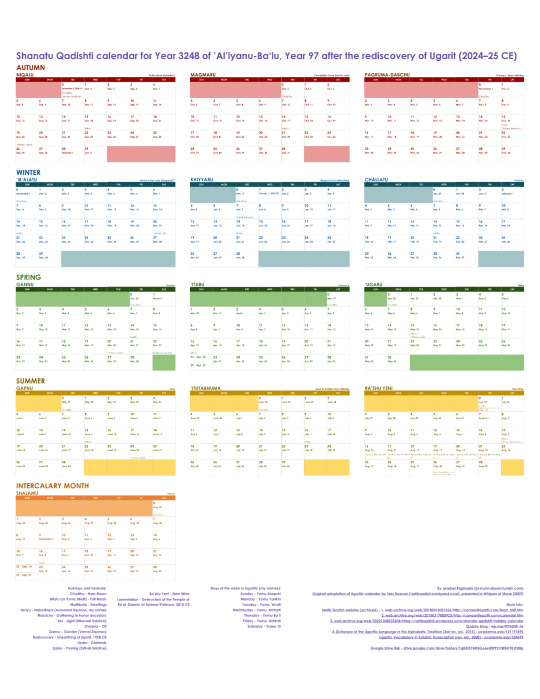
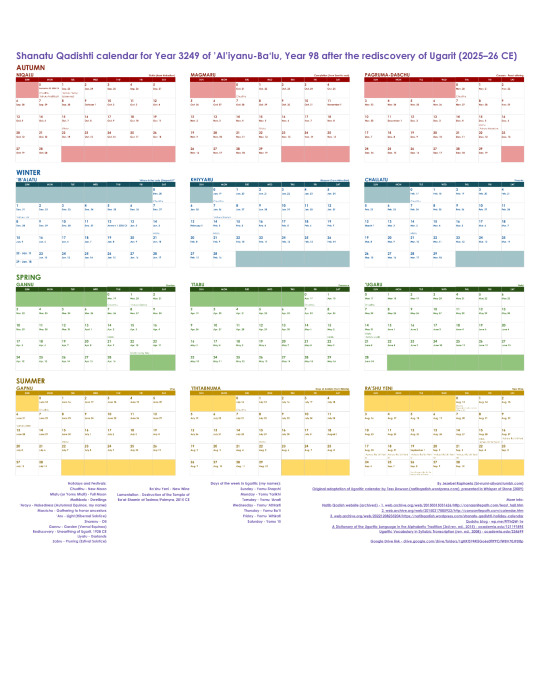
Here's the versions set to Ugarit's lunation if an "ecumenical" variation of the calendar would ever be necessary. I'd imagine for most, though, it'd be preferable to go off their own locale. Files are on the same Drive link as before '。˚⋆˙‧₊ .
#ancient near east#pagan#paganism#semitic pagan#semitic paganism#ancient levant#polytheism#polytheist#ugarit#ugaritic#ugaritic mythology#canaan#canaanite#canaanite pagan#canaanite paganism#canaanite polytheism#ritual calendar#baal#el#asherah#astarte#anat#shapash#yarikh#pagan festival#pagan holidays#lunar calendar#lunisolar calendar#festival#holiday
33 notes
·
View notes
Text
Some unexpected insight with Lady ʿAshtart
Shulmu 𒁲𒈬, friends! I wanted to share something here that will likely come off as rambling and incoherent, but I still think it's worth sharing for my own sake if nothing else. My Sacred Image of 𒀭Lady ʿAshtart, a Goddess I've been wondering of getting closer to, took on some heat damage (pictured). At first, this made me anxious that it could be a bad omen or even that the Deities were angry at me. However, it's actually given me some valuable opportunity to reflect.

(Model link)
The Image may no longer be "perfect" according to its original form, but it is no less sacred or precious for this. Despite my own religious trauma leading me to sometimes think of the Divine as primarily looking for any reason to count infractions against me, the Deities I have devoted myself to are compassionate and exceeding in kindness above all else. They have no need to concern themselves with our hangups about "perfection" nor do they care for us any less for not reaching arbitrary standards, as is unfortunately so often the case in human relationships. This also holds a more visceral significance for me.
Bodies and especially women's bodies are subject to a quite stressful degree of scrutiny in society obsessed with physical appearance. The sort of thing is all too commonly used by people as a reason to disparage and demean and just plain hurt each other. This naturally reflects in how we conceive of and interact with the Divine, as spirituality at its core has to do with how humans relate to our environment and one another. It happens even through expansive gulfs in time: refer to how just about any ancient Sacred Image in feminine form is automatically classified as a "fertility idol" or some such concept by male-dominated academia based on their own perceptions of womankind.*
As meandering as that all may sound, it means something important to me; Being a trans woman at this time and place is scary for me and for so many others. This obviously isn't because we did anything to collectively deserve mistreatment, but rather because a depressing number of people figure their repressive ideas of what a woman is "supposed to be" give them license to harm those who don't conform to them. They refuse to earnestly engage with, let alone make an honest effort to understand, any human experience beyond their own purview and instead dismiss it out of hand as "sin", "mental illness", "gender ideology", etc.
Such individuals who voluntarily remain clouded in obstinate bigotry ultimately do not get to dictate our lives, our minds, and even our very selves to us, no matter how hard they try. As society becomes more and more unsafe for women who don't look or act or talk how they're "supposed to", we nonetheless remain and consequently grow closer to each other. When all bets are off, it becomes all the more critical that we the marginalized look out for one another.
Despite (or perhaps to some extent because of) my general social isolation, it's for the same sort of reason that I find unexpected but welcome comfort from my not quite "perfect" Image of 𒀭ʿAshtart. I hold it close to me and I feel the affection of the Lady, Whose love isn't dependent on what something like trauma would have me assume it to be. If I am present and I say Her Name, that is enough. I honestly don't even feel like I'm "all here" some of the time, but I know She won't hold it against me for not having it all figured out right now. I can hope that past all the pain and heartache, there are greater things waiting for me and for all of us over the horizon. It's okay to not be "perfect" or even "normal". It's okay to just be. It's okay.
*To ramble like an insane person elaborate upon this as a side note, take female figurines of the Upper Paleolithic in Europe as an example: These have been most commonly referred to as "Venus" figures based purely on male gaze. For the same reason, unwarranted speculations of how these figurines may reflect "beauty standards" and flatly ridiculous hypotheses that they functioned as prehistoric pornography are regarded as holding scholarly merit. In effect, modern men have placed themselves at the center of the Upper Paleo societies which produced these figurines despite mounting evidence (e.g. the apparent prevalence of women among painted hand stencils in caves) indicating women were certainly not restricted to a peripheral role therein. To put it another way, such bare celebrations of femininity if nothing else are subject to fanciful extrapolation by these self-supposed wise and learned men to the effect of hijacking prehistoric people's lives and experiences to write a story featuring themselves as the protagonists with women relegated to acting as sidekicks at best. I find something poetic in how as our understanding so awkwardly advances, these sidelined women are, in a sense, providing their uncompromising rebuke to such treatment across untold millennia.
#ancient near east#pagan#paganism#semitic pagan#semitic paganism#ancient levant#polytheism#polytheist#canaan#canaanite#canaanite pagan#canaanite paganism#canaanite polytheism#ashtart#astarte#phoenician#phoenicia#spirituality#religion#faith#goddess#goddesses#spiritual reflection#deities#religious trauma#sacred image#idol#imperfection#canaanite mythology#queen of heaven
12 notes
·
View notes
Text

A candle for 𒀭Lady ʾAshirat of the Sea as Springtime begins 🕯️🌴🌅
O 𒀭Lady ʾAshirat of the Sea,
Please bless me and keep me throughout this new Season
So that I may endure in Your good time, O Great Mother.
Shulmu 𒁲𒈬 and a blessed Spring to all! 💚
#ancient near east#pagan#paganism#semitic pagan#semitic paganism#ancient history#ancient levant#bronze age#history#Ashirat#Asherah#Canaan#Iron age#Canaanite#canaanite pagan#canaanite paganism#Phoenicia#phoenician#Spirituality#Faith#Prayer#Canaanite polytheism#polytheist#polytheism#Goddess#Goddesses#Spring#Springtime#vernal equinox#spring equinox
19 notes
·
View notes
Text
Shulmu 𒁲𒈬, all! I haven't abandoned this place, just have a lot going on and most of it not good. My phone decided to self-destruct with all my files a little while ago and I'm still struggling with disorganized thinking and mental anguish in general. I've been trying to keep up with learning, though, and hopefully I'll have more to post here soon. For now, here's something which came to me a while ago:

#ancient near east#pagan#paganism#semitic pagan#semitic paganism#ancient levant#polytheism#polytheist#ancient history#spirituality#el#canaan#canaanite#canaanite pagan#canaanite paganism#canaanite polytheism#deity worship#phoenicia#Phoenician#Ugarit#ugaritic#ugaritic mythology
10 notes
·
View notes
Text

Another out-in-the-woods setup 💚
I really wish I was more active on here, I've just been absolutely clobbered with anxiety and everything else 😓 I wanna do more for the Deities, though, like praying more regularly and even composing more of my own prayers. I'll try to post more of my Semitic Pagan life as it comes like I said before, I just wish I wasn't so terrified of failure. Please pray for me if you pray much at all, I could certainly use it. Shulmu 𒁲𒈬 to you all!
#ancient near east#pagan#paganism#semitic pagan#semitic paganism#ancient levant#baal#Asherah#Altar#Canaan#Canaanite#canaanite pagan#canaanite paganism#canaanite polytheism#Polytheism#Polytheist#Phoenicia#phoenician#Ugarit#Ugaritic#Faith#Spirituality#Religion#Spiritual#bronze age#Iron age#ancient history#history#Yahweh#Yhwh
10 notes
·
View notes
Text
Two prayers from ancient ʾUgarit
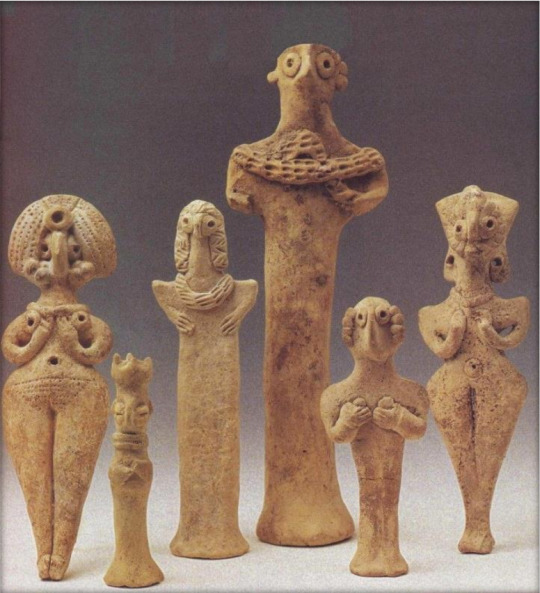
Various “Teraphim” figures representing deities for devotional purposes from ancient Canaan/Judah. Photo from “Exhibit from the Bible Lands Museum” (Biblical Archaeology Review Vol. 25:5 (Sep.–Oct. 2000), p. 22). Source: Fertility Goddesses from the Ancient Near East (Mar. 2000) by Wanda Roux, https://www.semanticscholar.org/paper/Fertility-goddesses-from-the-Ancient-Near-East-Roux/218a301d5b1f807dd2324e37257cc817912ceeed.
Shulmu 𒁲𒈬 to all! These are a couple more Ugaritic prayers I've given my own take on and filled in blanks based on scholarly texts. The first of these is addressed to 𒀭Prince Baʿal and is found appended to a bimonthly itinerary of Temple rituals classified as KTU 1.119 (=RS 24.266). My source for the text is Pardee 2002 (I mention these works often enough I figure I'll probably make a bibliography), pp. 50–53, 149–50 and the translation in Wyatt 2002, pp. 416–22. The next prayer, found on tablet KTU 1.65 (Wyatt 2002, pp. 363–65), also has a liturgical character and appears to have originally been concerned with the wellbeing of the City of ʾUgarit. I've tried to adjust language in both prayers to make them flow as well as possible in English with a distinct ancient tone and I really hope you like what I've got here.
Prayer to Baʿal for Protection
When a terrible foe storms your gate,
a marauder dashes your walls,
You shall lift up your eyes to 𒀭Baʿal and say:
“O 𒀭Baʿal, if You drive the terrible foe from our gate,
“banish the marauder from our walls,
“an offering, O 𒀭Baʿal, we shall sanctify,
“a vow, O 𒀭Baʿal, we shall fulfill;
“a heritage, O 𒀭Baʿal, we shall sanctify,
“a Propitiation, O 𒀭Baʿal, we shall fulfill,
“a feast, O 𒀭Baʿal, we shall offer;
“to the Sanctuary, O 𒀭Baʿal, we shall ascend,
“the paths of the Temple, O 𒀭Baʿal, we shall follow.”
and 𒀭Baʿal will hear your prayer:
He will drive the terrible foe from your gate,
banish the marauder from your walls.
Prayer to ʾEl and the Family of the Deities
O Deities of the House of 𒀭ʾEl,
Family of the Deities,
Assembly of the Deities,
𒀭Thukamuna and 𒀭Shunama.
O 𒀭ʾEI and 𒀭ʾAshirat,
Show us grace, O 𒀭ʾEl,
Come to our assistance, O 𒀭ʾEl,
Grant us peace, O 𒀭ʾEI.
𒀭ʾEI, come close,
𒀭ʾEI, be our guard,
for the love of 𒀭Baʿal of 𒀭Ṣapon,
for the hope in 𒀭Baʿal of ʾUgarit.
By the Holy Spear,
by the Holy Axe,
by the Holy Mace,
by the Holy Javelin.
By the Holy Burnt-Offering,
by the Holy Perpetual Offering,
by the Holy Morning Offering,
by the Holy Evening Offering.
By the Holy Censer and Lyre,
by the Holy Image and Propitiation,
by the Holy Threshold and Keystone,
by the Holy Song and Scribal Instruments,
by the Holy Grain-Offering and Young Wine.
O Deities of the Holy Mountain,
Gods and Goddesses in the Dwelling and Court,
remember us at the Assembly in Council,
by your rulings grant us peace in your good time.
#semitic pagan#semitic paganism#pagan#paganism#ancient history#ancient near east#history#canaanite paganism#canaanite pagan#canaan#canaanite#el#asherah#baal#gods#goddess#goddesses#spirituality#polytheism#polytheist#canaanite polytheism#ugarit#ancient levant#faith#religion#ancient religion#ancient world#phoenicia#bronze age#ugaritic
19 notes
·
View notes
Text




L–R: The ʾAsherah, the Mizbeach, and the Maṣṣebah

𒀭Yarikh 🌒 and 𒀭ʿAshtart ♀

Shulmu 𒁲𒈬. I was able to perform my first regular offerings yesterday evening and I'm very happy about it! I used almost all natural elements as you can see and it went pretty great I feel. As you can expect with me, it wasn't quite as organized as had perhaps been hoped, but I made sure to guard against carelessness and be reverent and I believe the Deities understand. At the very least they may have gotten me back when a thorn branch walloped me right in the nose as I was making my way out of the woods :P
I paid honors to 𒀭ʾEl, Creator of Earth, and His House (water for gratitude), 𒀭Baʿal the Victorious (contents of my heart for the protection of trans and queer people), and 𒀭ʿAnat Mutilated (I'd prefer to keep the specifics of this one private). I'm very excited to spend more time learning and practicing with the ʾElim. I think I'll probably start performing offerings weekendly if I'm able. I've been keeping up with my daily prostrations to 𒀭Shapash to the extent I've been able to as well, though I substituted them with hymns yesterday evening and this morning due to fatigue and hurting myself on something at home (I'm ok now! <3).
I'd like to thank everyone within the Semitic Pagan and Kemetic communities who's helped me along so far, especially J. Sullivan who's provided me with a wealth of great info and advice lately :)
#pagan#paganism#semitic pagan#semitic paganism#ancient levant#baal#bronze age#history#ancient near east#ancient history#canaanite pagan#canaanite paganism#canaanite#canaan#canaanite polytheism#polytheist#polytheism#phoenician#phoenicia#punic#anat#el#yarikh#astarte#faith#religion#spirituality#altar#ritual#shapash
10 notes
·
View notes
Text
Two incantations from ancient Ugarit and a prayer of my own composition

A horse figurine from the ancient Judahite cultic site of Tel Motza, c. 750 BCE (Source)
Shulmu 𒁲𒈬! I hope all my readers are having a wonderful day. I'd imagine what's going on lately is taking as much of a toll on some of you as it is on me. I haven't been feeling my best as a result and this took my mind back to what I find to be one of the most interesting texts in the Ugaritic corpus. KTU 1.100 is part myth, part incantation and it describes 𒀭Shapash's efforts to find a spell which will cure Her Daughter, the 𒀭Mother-of-Horses, who had fallen victim to snake venom. The text itself leaves quite a lot of room for interpretation, so I'll leave such judgements to the reader. The sources for KTU 1.100 (=RS 24.244) in translation with more info are Pardee 2002 pp. 172–79, Wyatt 2002 pp. 378–87, and Ugaritic Narrative Poetry (1997, pp. 219–23) edited by Simon B. Parker.
Before that, however, I'd like to first share an actual ancient spell against the Evil Eye, classified as KTU 1.96 (=RS 22.225) and to be found translated in Pardee 2002 pp. 161–62 and Wyatt 2002 pp. 375–77. It's also been interpreted as referring to 𒀭Maiden ʿAnat's sexual and/or cannibalistic acts involving 𒀭Baʿal which is certainly intriguing. The Ugaritic text is missing an indeterminate number of lines and I decided to rectify this by simply completing the apparent chiasm.
Finally, I'd like to include a brief prayer to 𒀭 Milqart I wrote myself drawing mainly from what appears to be an Ugaritic royal funerary text associated with 𒀭'Niqmaddu IV (formerly reckoned Niqmaddu III), the penultimate King of Ugarit who passed away in the late 13th century BCE (KTU 1.108 = RS 24.252, Pardee 2002 pp. 192–85). It's also influenced by the founding myths of Sur and Qart-Chadasht. I really hope you enjoy reading these and you may find them useful in your own practice <3
Incantation Against the Evil Eye: Attack and Counterattack
The Evil Eye roves about, it prowls,
and disfigures the beauty of its Brother
and the grace of its Brother,
although He be altogether lovely,
it devours His Flesh without a knife,
drinks His blood without a cup.
The eye of a wicked one that has seen Him,
the eye of a price-setter,
the eye of an assembler,
the eye of a gatekeeper.
The eye of the gatekeeper, to the gatekeeper let it return!
The eye of the assembler, to the assembler let it return!
The eye of the price-setter, to the price-setter let it return!
The eye of the wicked one, to the wicked one let it return!
No more drink His Blood without a cup,
no more devour His Flesh without a knife!
For He be altogether lovely,
no more disfigure the grace of your Brother!
No more disfigure the beauty of your Brother!
Evil Eye, nevermore rove about and prowl here!
Incantation Against Bane: Shapash and the Mother-of-Horses
I. The 𒀭Mother-of-Horses,
𒀭Mother of Stallion and Mare,
Daughter of the Spring, Daughter of the Stone,
Daughter of the Heavens and the Abyss,
Calls to 𒀭Shapash, Her Mother:
“𒀭Shapash, My Mother, carry My Cry
“to 𒀭ʾEl at the Source of the Two Rivers,
“at the Confluence of the Channels of the Two Deeps:
“‘For a spell for a serpent's bite,
“‘For a sloughing serpent's venom;
“‘from it, O Charmer, banish the bane,
“‘from it cast out the poison;
“‘then bind the serpent,
“‘dismiss the sloughing serpent,
“‘draw up a chair and sit.’”
II. She again calls to 𒀭Shapash, Her Mother:
“𒀭Shapash, My Mother, carry My Cry
“to 𒀭Baʿal on the Heights of 𒀭Ṣapon:
“‘For a spell for a serpent's bite,
“‘For a sloughing serpent's venom;
“‘from it, O Charmer, banish the bane,
“‘from it cast out the poison;
“‘then bind the serpent,
“‘dismiss the sloughing serpent,
“‘draw up a chair and sit.’”
III. She again calls to 𒀭Shapash, Her Mother:
“𒀭Shapash, My Mother, carry My Cry
“to 𒀭Dagan in Tuttul:
“‘For a spell for a serpent's bite,
“‘For a sloughing serpent's venom;
“‘from it, O Charmer, banish the bane,
“‘from it cast out the poison;
“‘then bind the serpent,
“‘dismiss the sloughing serpent,
“‘draw up a chair and sit.’”
IV. She again calls to 𒀭Shapash, Her Mother:
“𒀭Shapash, My Mother, carry My Cry
“to 𒀭ʿAnat and 𒀭ʿAshtart on ʾInbubu:
“‘For a spell for a serpent's bite,
“‘For a sloughing serpent's venom;
“‘from it, O Charmer, banish the bane,
“‘from it cast out the poison;
“‘then bind the serpent,
“‘dismiss the sloughing serpent,
“‘draw up a chair and sit.’”
V. She again calls to 𒀭Shapash, Her Mother:
“𒀭Shapash, My Mother, carry My Cry
“to 𒀭Yariḫ in Larugatu:
“‘For a spell for a serpent's bite,
“‘For a sloughing serpent's venom;
“‘from it, O Charmer, banish the bane,
“‘from it cast out the poison;
“‘then bind the serpent,
“‘dismiss the sloughing serpent,
“‘draw up a chair and sit.’”
VI. She again calls to 𒀭Shapash, Her Mother:
“𒀭Shapash, My Mother, carry My Cry
“to 𒀭Resheph in Bibitta:
“‘For a spell for a serpent's bite,
“‘For a sloughing serpent's venom;
“‘from it, O Charmer, banish the bane,
“‘from it cast out the poison;
“‘then bind the serpent,
“‘dismiss the sloughing serpent,
“‘draw up a chair and sit.’”
VII. She again calls to 𒀭Shapash, Her Mother:
“𒀭Shapash, My Mother, carry My Cry
“to 𒀭ʿAshtar in Mari: [𒀭Ashtar here is emendation from "Ashtart" based on a similar list found in KTU 1.107 (Wyatt 2002 pp. 391–94) and the fact 𒀭Ashtart is already mentioned in IV.]
“‘For a spell for a viper's bite,
“‘For a sloughing viper's venom;
“‘from it, O Charmer, banish the bane,
“‘from it cast out the poison;
“‘then bind the viper,
“‘dismiss the sloughing viper,
“draw up a chair and sit.’”
VIII. She again calls to 𒀭Shapash, Her Mother:
“𒀭Shapash, My Mother, carry My Cry
“to 𒀭Ẓiẓẓu-wa-Kamathu in Ḥuriyat: [This is 𒀭Kemosh, the National Deity of Iron-Age Moab]
“‘For a spell for a serpent's bite,
“‘For a sloughing serpent's venom;
“‘from it, O Charmer, banish the bane,
“‘from it cast out the poison;
“‘then bind the serpent,
“‘dismiss the sloughing serpent,
“‘draw up a chair and sit.’”
IX. She again calls to 𒀭Shapash, Her Mother:
“𒀭Shapash, My Mother, carry My Cry
“to 𒀭Milku in ʿAshtartu: [This City's name becomes "Ashtoreth" in the Hebrew Bible with the vowels for בּשֶׁת (bosheth, "shame") inserted based on a postexilic Judean taboo against pronouncing the old Deities' Names as followed by monotheistic redactors.]
“‘For a spell for a serpent's bite,
“‘For a sloughing serpent's venom;
“‘from it, O Charmer, banish the bane,
“‘from it cast out the poison;
“‘then bind the serpent,
“‘dismiss the sloughing serpent,
“‘draw up a chair and sit.’”
X. She again calls to 𒀭Shapash, Her Mother:
“𒀭Shapash, My Mother, carry My Cry
“to 𒀭Kothar-wa-Ḫasis in Caphtor:
“‘For a spell for a serpent's bite,
“‘For a sloughing serpent's venom;
“‘from it, O Charmer, banish the bane,
“‘from it cast out the poison;
“‘then bind the serpent,
“‘dismiss the sloughing serpent,
“‘draw up a chair and sit.’”
XI. She again calls to 𒀭Shapash, Her Mother:
“𒀭Shapash, My Mother, carry My Cry
“to 𒀭Shaḥar and 𒀭Shalim in the Heavens:
“‘For a spell for a serpent's bite,
“‘For a sloughing serpent's venom;
“‘from it, O Charmer, banish the bane,
“‘from it cast out the poison;
“‘then bind the serpent,
“‘dismiss the sloughing serpent,
“‘draw up a chair and sit.’”
XII. She again calls to 𒀭Shapash, Her Mother:
“𒀭Shapash, My Mother, carry My Cry
“to 𒀭Ḥoron in the Fortress:
“‘For a spell for a serpent's bite,
“‘For a sloughing serpent's venom;
“‘from it, O Charmer, banish the bane,
“‘from it cast out the poison.’”
XIII. 𒀭Shapash turns Her Face to 𒀭Ḥoron
for She is to be bereaved of Her Child.
He returns to the City of the East
then straightaway He sets His Face
towards Great ʾArashshiḫ,
towards ʾArashshiḫ the Well-Irrigated.
From the trees He casts out the tamarisk,
from the shrubs the Tree of Death.
With the tamarisk He expels the venom,
with the cluster of dates He drives it out,
with the foliage He dismisses it,
with the roots He carries it off.
Then 𒀭Ḥoron goes to His House
and arrives at His Court.
The poison peters out like in a stream-bed,
washes away as though in a canal.
XIV. Behind the 𒀭Mother-of-Horses the House of Incantation,
behind Her the House She shut,
behind Her the bronze bolt She set.
𒀭Ḥoron: “Open the House of Incantation,
“Open the House and let Me in,
“the Palace let Me in.”
𒀭Mother-of-Horses: “Give as My dowry serpents, O Horan,
“as My dowry a toxic lizard,
“as My wedding gift the viper's brood.”
𒀭Ḥoron: “As Your dowry I give You serpents,
“as Your wedding gift the viper's brood.”
Prayer to Milqart of the House of Freedom
Praises to You, 𒀭Holy Milqart of Sur!
Glory to Your Name, Victorious Son of 𒀭Baʿal!
You alone are Foremost in the House of Freedom,
all the Blessed Dead rejoice by Your Throne.
When Your Company vanquishes the Shifting Serpent,
You make rampage with the Club in Your Hand,
The Axe of Your Right Hand gleams with blood.
When the Stones wandered the Ocean,
the Sons of the Mother of Wells around the Oil Tree,
Only You could tell them where to settle.
The violet of snails is wrought by Your edict
and You alone guide the Queen to Her Crown Land.
We lift a song of love to the King of Eternity,
our hearts abide in 𒀭Rapiʾu, the Great God.

Thanks so much for reading! I did want to share in other news that I performed my first daily prostrations this morning and I feel pretty happy about my spiritual progress in general. I almost made some offerings yesterday, but I didn't feel like I was in the headspace for it and I'll probably try again this weekend.
#canaan#pagan#paganism#magic#spell#incantation#utterance#ancient history#ancient near east#history#semitic pagan#semitic paganism#ancient levant#baal#bronze age#shapash#astarte#anat#el#evil eye#canaanite pagan#canaanite paganism#canaanite#phoenician#phoenicia#ugarit#ugaritic#polytheism#canaanite polytheism
12 notes
·
View notes
Text
Shulmu 𒁲𒈬, my friends! I wanted to let you know I haven't forgotten about this place whatsoever. I actually started writing something big, but I got sidetracked with various other things. Again, though, I haven't forgotten and I'm gonna commit to making sure I don't neglect the Shrine! To make up for it, I'd at least like to share some sketches I've made in the meantime :)

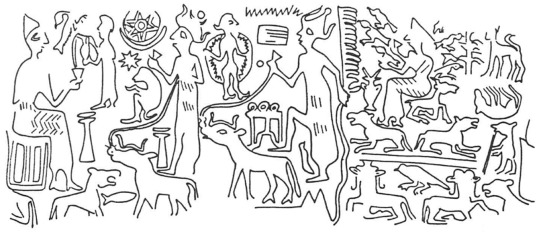
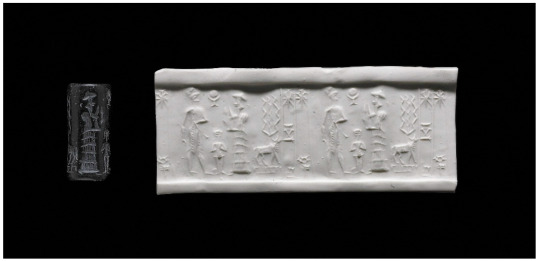


First up are some more Deity symbols! The Seal of 𒀭ʿAshtart-Shala, going on my perspective that West Semitic 𒀭ʿAshtart and East Semitic 𒀭Shala are the same Goddess, is based on designs associated with the "Storm God's Wife" type in different regions as well as an Ugaritic Astral symbol. I also see it symbolizing something of the Celestial Realm in general, interestingly enough.
The Four-Pointed Star is associated with 𒀭Hadad in ancient times. The “War” variant is based on a metal standard from Ugarit (I'm not sure on what basis it's called a Hittite symbol, perhaps that version comes from Anatolia). There's also a Sun-and-Moon symbol (doesn't it just barely remind you of something very... Catholic?) and the Lightning-Fork, the East Semitic precursor to 𒀭Baʿal's ʾArzu (Cedar) in Levantine myth and iconography. Both of these are from an Old Babylonian cylinder seal.
With 𒀭ʿAshirat, there's two Sacred Tree symbols and what looks to have been a fertility motif from Canaanite pendants. There's also a design from a Megiddo cylinder seal (I was thinking of something else when I wrote “Old Syrian”) which I didn't finish drawing and you can even see where I erased some elements which I still mean to redraw so I can finish the thing.


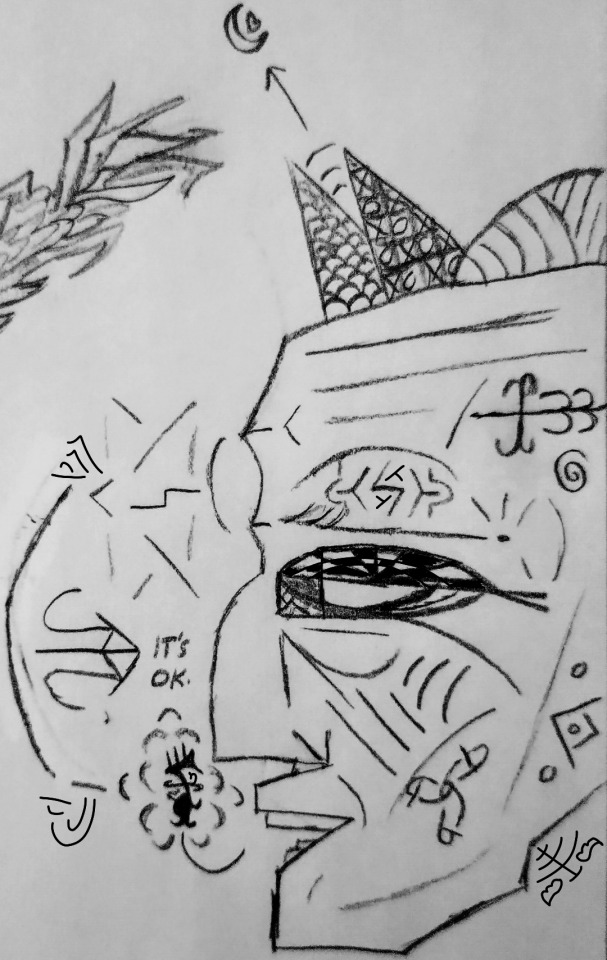
Next are two drawings of 𒀭Milqart! The first one started out in concept as a sort of Seal, but to be honest I just think it turned out an alright drawing if I may say so. The basic design comes from Tyrian coinage, albeit I chose to reinterpret it with more Ancient Near Eastern as opposed to more Hellenic symbolism (no disrespect for Hellenism!). The King of Eternity's bespoke apparel and wings are mostly based on the Assyrian “genies”, although I certainly do not intend to imply any connection with that. His garment also draws from a Phoenician-influenced engraved silver bowl of the Latin culture (which shows Him bodying a fucking gorilla btw). His Crown has horns and a long tassel much like Ba'al's is sometimes portrayed along with some geometric motifs inspired by Atef. I decided to do something geometric with the Celestial symbols as well. He holds His two Attributes representing Life and Death, the Ankh and the Phoenician Fenestrated Axe respectively. Life is symbolically offered up on the Horned Altar inspired by an actual one from the Roman period.
Tyre's founding myth of the Ambrosial Rocks is also portrayed with the Eagle and Snake living together in harmony in the Oil (Olive) Tree which the Rocks wandered around in the midst of the Sea until 𒀭Milqart told them where to settle. I originally decided to put a proto-alphabetic Alef and Bet ;) on the Rocks based on the assertion the term “Ambrosial” is derived from Semitic ʿAmm Beruth meaning “Mother of Wells.” I couldn't find any good evidence for that, but I decided to have them there anyway to symbolize beginning (albeit I realize now they should be in reverse). The Eagle offers 𒀭Milqart a Wreath Crown with the Pillars of the Two Tyres. On the lower register is the myth of 𒀭Milqart's Dog biting a Murex Shell which led Him to discover the precious Tyrian Purple dye and the whole composition is framed by Wreaths.
The Head of Milqart was purely a creative/inspirational outflowing with some slight tweaks made in post.


This next one is something of a personal seal for me. It's mostly based on the 𒀭ʿAshtart-Shala symbol and this is to ask for protection. The triple-ʿAlef in the midst of the Hexagram represents my chosen Pagan name to that effect. The Name of 𒀭Qadesh-ʿAshtart-ʿAnat, Who is a “composite” Goddess in my view, is written on the Lunar Crescent and I recycled some of the Tyrian symbolism as well. The two symbols on either side are based on designs of sceptres held by ancient Images of 𒀭ʾEl, one representing His House and the other a Solar symbol.
The Head of Baʿal here is in the same category as the Head of Milqart.
Thanks for checking out my work, I really hope you enjoyed it :)
#ancient history#ancient near east#history#pagan#paganism#semitic pagan#semitic paganism#ancient levant#baal#bronze age#canaanite pagan#canaanite paganism#pagan art#gods#goddesses#melqart#asherah#astarte#anat#qetesh#canaanite polytheism#canaan#phoenicia#phoenician#canaanite#classical antiquity#religion#faith#spirituality#spiritual art
8 notes
·
View notes